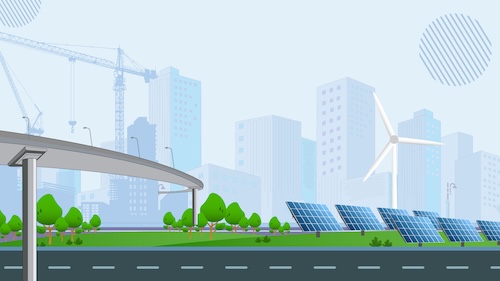India's urban population is expected to increase by 416 million by 2050.1 As the country shifts from a mainly rural to an urban demographic, leveraging the economic potential of tier 2 and 3 cities will be crucial.
In recent years, these cities have seen a rise in economic activities, including investments and job creation. To help them develop and evolve into thriving economic centres, government and trade initiatives must provide necessary support.
What are tier 2 and 3 cities in India and what role do they play in India's economic growth?
Indian cities are classified into different tiers based on their population sizes.2 Tier 2 cities have a population of one to five million and offer a lower cost of living compared to tier 1 cities. Examples of tier 2 cities include Visakhapatnam, Kochi and Raipur. Meanwhile, tier 3 cities have a population ranging from 0.1 to 1 million; examples include Nagpur, Indore, Patna Bhopal among others.
Tier 2 and 3 cities are emerging as major drivers in the nation's economic growth by fostering MSMEs, creating employment opportunities and stimulating regional development. Here is a more detailed look at their contributions:
a) Growth of MSMEs
Tier 2 and 3 cities are home to a sizeable fraction of India's MSMEs, accounting for 51% of the nation's registered MSMEs3. The allure of lower operating costs, expanding consumer demand and robust government support draws in both entrepreneurs and investors. Improving infrastructure and connectivity will further enhance the growth of MSMEs and optimise supply chains across the nation.
b) Regional development
Economic activity in tier 2 and 3 cities both necessitates and leads to accelerated enhancement of infrastructure, healthcare and technical education. It boosts the local economy of the region and create employment opportunities across industries such as manufacturing, IT and operational services. The number of female job applications alone has increased exponentially between 2021 and 2024 in these cities for a variety of roles, including sales and business development, field sales and delivery and logistics.4
c) Inclusive and sustainable growth
The rapid expansion of these cities offers opportunities to create and promote energy-efficient and sustainable industries. Adopt eco-friendly operational procedures, such as efficient processes for recycling, collecting and segregating industrial waste. Ensuring that the nation's overall economic growth is sustainable and resilient.
What government initiatives are driving investment in these cities?
Several initiatives are supporting investments and growth in these cities aimed at enhancing infrastructure, efficient logistics and digital adoption. Here are some notable government schemes and policies aimed at promoting the growth and development of these cities.
a) Smart Cities Mission
Launched in June 2015, the Smart Cities Mission5 aims to boost economic growth in 100 selected non-metropolitan cities by enhancing infrastructure and building environmentally sustainable institutions. By December 2024, the mission had successfully accomplished 7,380 of its approved 8,075 projects with a total investment of ₹1,47,704 crore.6
b) Atal Mission for Rejuvenation and Urban Transformation (AMRUT)
The Atal Mission for Rejuvenation and Urban Transformation (AMRUT) initiative was first launched in June 2015 and later superseded by AMRUT 2.0 in October 20217, under the Ministry of Housing and Urban Affairs. It aims to provide 500 cities with water security by revitalising water sources, creating parks and green areas and using technology for robust sewage management. With a total outlay of ₹2,99,000 crore for five years, 8,998 projects worth ₹1,89,458 crore have already been undertaken by AMRUT 2.0, as of November 2024.
c) Pradhan Mantri Mudra Yojana (PMMY)
The Pradhan Mantri MUDRA Yojana (PMMY), launched in April 2015, offers collateral-free loans to small and micro businesses. Initially, the programme provided loans of up to ₹10 lakh, but the ceiling for these loans was raised to ₹20 lakh in the Union Budget 2024-25.8 These loans are offered through banks, NBFCs, MFIs and other financial institutions, with the new limit taking effect in October 2024.
d) UDAN (Ude Desh ka Aam Naagrik) Scheme
Launched by the Ministry of Civil Aviation (MoCA), the Ude Desh ka Aam Naagrik (UDAN) Scheme9 aims to support logistics and facilitate regional air travel to and from tier 2 and 3 cities with the rest of the nation. The scheme has connected 88 cities and operationalised 618 routes so far. In Union Budget 2025-26, it was announced that the scheme will be extended to 120 new destinations and carry over four crore passengers in the next 10 years.10
What are the advantages of investing in these cities compared to tier 1?
These cities offer distinct advantages to the savvy investor. Not least of which are higher returns on investments, lower operational costs, cheaper real estate and a large talent pool that prefers the healthier lifestyle of these cities over that of metro cities. Investments in the digital infrastructure of these cities will further enhance their appeal for remote workers and industries like IT services.
With the growth of industrial clusters, several of these cities are emerging as important corporate destinations. Government programmes to promote infrastructure and employment are frequently targeted at tier 2 and 3 cities, offering investors opportunities that tier 1 cities can't capitalise on.
How is infrastructure in smaller cities being improved by the UIDF?
The Urban Infrastructure Development Fund (UIDF) is enhancing infrastructure in smaller cities by providing affordable, long-term funding for projects that improve essential services such as waste management, sanitation and water delivery. Under the management of the National Housing Bank11, the UIDF provides support to state governments and Union Territories in their initiatives to develop urban infrastructure through public/state agencies, municipal corporations and urban local bodies. An annual budget of ₹10,000 crore12 has been designated for this initiative, which has been operational since November 2024.
Which rising urban centres in India provide the most investment opportunities?
While every city presents its unique blend of both possibilities and obstacles owing to distinctive economic profiles, here are a few that are likely to offer the highest rewards for investors.
a) Ahmedabad
Ahmedabad, the largest city in Gujarat, is known for its expertise in petrochemical and chemical manufacturing, shipbuilding, food and agribusiness, textiles, gems and jewellery and pharmaceuticals. The city presents appealing investment opportunities across various sectors and is home to many of the country's most recognised companies, demonstrating its strong credentials as an investment destination.
b) Nagpur
Easily connected to Mumbai, Nagpur offers an ideal entry point for imports and exports, being ideally situated on the nation's western coast. It provides a favourable geographic and business ecosystem with world-leading financial institutions, making Nagpur the ideal springboard for expansion into the rest of India.
c) Mysuru
With its burgeoning IT industry, expanding population and rich cultural legacy, Mysuru offers a wide range of investment options, especially in real estate. Public sector enterprises in the fields of software development, precision engineering, telecommunications, heavy industries, aviation and healthcare and pharmacy are located here. The city is emerging as a major contender in the manufacturing of heavy electrical equipment, machine tools and automobile machinery.
How are these cities benefiting from the Digital India initiative?
Led by the Ministry of Electronics and Information Technology, the Digital India Initiative13 since its inception in 2014, has been bridging the digital gap between urban and rural locations, including tier 2 and 3 cities and villages. Several technology-led enterprises and innovation schemes have been launched under this initiative with the aim of building and supporting digital infrastructure nationwide.
The total internet subscribers increased by 28.54% to 1,199.28 million, as of March 2024.14 Government support through the Digital India Initiative has facilitated investments in digital infrastructure by tier 2 and 3 cities, including digital payment systems, high-speed internet connectivity and e-governance programmes. In addition to improving connectivity, these programmes have sparked innovation, facilitated e-governance and digital entrepreneurship. The digital evolution of Tier-2, Tier-3, Tier-4 cities, and beyondhas also been a boon for the e-commerce and retail industry, with the small cities accounting for the largest volume of of all online orders in the country.15
How do industrial corridors contribute to non-metropolitan cities' expansion?
Industrial corridors, in addition to their significant advantages of enhancing connectivity and providing infrastructural support, also play a vital role in creating employment opportunities and bridging the economic growth gap that can develop between regions. Besides directly generating jobs, industrial corridors facilitate the creation of jobs indirectly in related industries and service sectors. Moreover, these corridors ensure a sustainable and robust supply chain by allowing commodities and services to move more freely.
Industrial corridors also provide opportunities for savvy investors, as they consist of established parcels of land designated for or undergoing infrastructural and economic development. By prioritising upgraded ports, railroads and roadways, industrial corridors enhance market accessibility and reduce logistical costs, which are significant advantages when considering investments.
How are government initiatives encourage the growth of smaller cities' real estate markets?
Focused on enhancing infrastructure and developing affordable housing, various government initiatives have boosted the growth of the real estate sector in tier 2 and 3 cities. Boosting connectivity and residential development, these initiatives have helped make the destination sought after for both top-tier talent and real estate investments. Notable among these government-led initiatives are:
Real Estate Regulatory Authority (RERA)
The Real Estate (Regulation and Development) Act, 201616, implemented under the aegis of the Ministry of Housing and Urban Affairs17 mandates that all real estate projects must be registered with the relevant State or Union Territory's (UT) Real Estate Regulatory Authority in accordance with RERA's rules. By safeguarding both the homebuyers' interests and ensuring accountability within the industry, RERA may take action to oversee any remaining development under the project, thereby securing investments and protecting investors.
Real Estate Investment Trusts (REITs)
Real Estate Investment Trusts (REITs) allow investors with smaller capital to invest and generate income from real estate assets without having to fund, manage or purchase properties. The government has implemented incentives and policy reforms to encourage REITs and maximise the value generated from real estate for investors. REITs that distribute at least 90% of their taxable income are eligible to avail tax-free dividend income.18 Moreover, long-term capital gains, held for more than a year, are subject to a lower tax rate than their short-term capital gains.
How can these cities continue to attract investments and grow sustainably?
To continue attracting investment, cities should continue investing in improving infrastructure, promoting renewable energy sources, diversifying their economies and implementing inclusive policies. From developing robust public transportation to building scalable healthcare systems, there are numerous avenues for investors to explore. But to ensure long-term investor engagement, a stable policy framework and incentives are key.
India's path towards becoming an economic powerhouse depends on promoting growth and development in tier 2 and 3 cities. As growth hubs of infrastructure, industries, education and sustainability, these cities have become major players on both the national and international stage.

